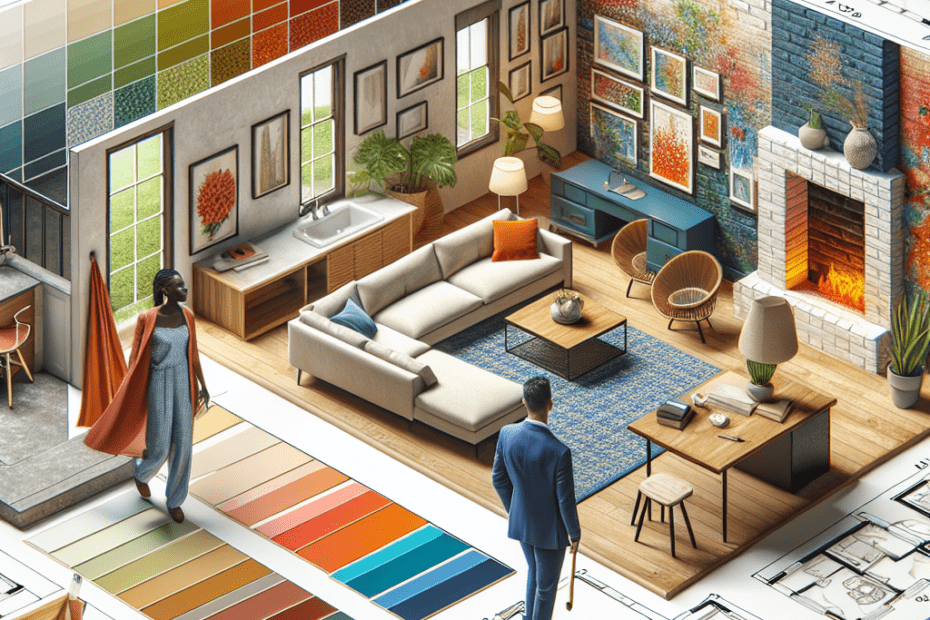“`html
Choosing Accent Walls: Elevating Your Home’s Aesthetic
When homeowners consider personalizing their space, they often find themselves pondering the transformative power of accent walls. Choosing accent walls is an effective means to reinvigorate a room without the need for a complete renovation. According to a study by the Home Decorating Institute, over 78% of interior designers believe an accent wall can instantly elevate a room’s vibe. But how exactly should one choose the right accent wall for their home?
Understanding the Basics of Accent Walls
An accent wall is simply a wall whose design differs from the others in a room. This contrast creates a focal point, drawing attention and setting the tone for the space. When done correctly, it can highlight architectural features, house art or photos, or simply bring warmth and depth to an otherwise neutral room.
The Importance of Color and Material
To select the perfect hue or material for an accent wall, homeowners should consider the existing decor of the room. They should choose colors that complement the present palette. Warm tones can create a cozy atmosphere, while cooler shades might lend an air of serenity. In terms of materials, options such as painted walls, wallpaper, and wooden finishes can significantly impact the room’s character.
| Material | Pros | Cons |
|---|---|---|
| Painted Wall | Easy to change, affordable | Requires regular maintenance |
| Wallpaper | Diverse designs, texture options | Tricky to apply and remove |
| Wood Finish | Natural look, adds warmth | Can be costly |
Position Matters
Choosing the right wall to accentuate is crucial. Designers often suggest selecting the first wall one sees upon entering the room. This wall is usually the best candidate for an accent wall. It’s important for homeowners to remember that accent walls are meant to be eye-catching, so placing them where they can be appreciated is key.
Paying Attention to Lighting
The lighting in a room affects how the color and texture of an accent wall are perceived. Natural lighting can have a different impact compared to artificial lights. For example, warm colors might be overly intense in strong sunlight but become subdued with dimmer evening lighting. Homeowners should observe their room at various times of day before making a final decision.
Embracing Personal Style and Trends
While trends in interior design can guide choices, personal preferences should take precedence. Some might prefer bold, dark colors, while others might lean toward pastel shades or nature-inspired tones. According to a 2023 Interior Design Quarterly report, 61% of homeowners found greater satisfaction in rooms decorated to reflect their personal tastes, rather than conforming strictly to trends.
Coordinating with Furnishings
An effective accent wall should enhance the overall aesthetic of the room, harmonizing with the existing furniture and decor. They should evaluate the color and style of their furniture and consider how it will look against the backdrop of the accent wall. For instance, a minimalist setting might benefit from a vivid accent wall, whereas a richly decorated room may fare better with a subtle, textured wall.
Key Takeaways
- Accent walls can transform a room by creating a focal point.
- Consider the color and material in context with the room’s existing decor.
- The wall chosen for accentuating should be strategically visible.
- Lighting significantly influences the appearance of accent walls.
- Aligning with personal style and ensuring harmony with furnishings enhances satisfaction.
FAQ Section
1. What is an accent wall?
An accent wall is a wall within a room that is decorated differently than the other walls, often in contrasting colors or materials to create a focal point.
2. Which rooms are best suited for accent walls?
Accent walls can be used in any room, but they are particularly effective in living rooms, bedrooms, and dining areas where people spend significant time.
3. Is it necessary for the accent wall to be painted a bold color?
No, accent walls do not always need to be bold. Some may have subtle changes, like texture differences or muted colors that still catch the eye.
4. How important is the choice of material for an accent wall?
The material choice is significant as it can affect the durability, maintenance, and overall feel of the room.
5. Should the flooring impact the choice of an accent wall?
Yes, coordinating the accent wall with floor color and material is advisable to ensure a cohesive room design.
Choosing accent walls offers a plethora of options and inspirations for personalizing one’s space. By considering factors like color, material, lighting, and personal style, homeowners can create a striking wall that complements their decor and elevates the room’s ambiance.
“`
